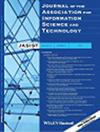The Theoretical Foundation of Zipf's Law and Its Application to the Bibliographic Database Environment
Journal of the American Society for Information Science and Technology
Pub Date : 2007-09-06
DOI:10.1002/asi.4630330507
引用次数: 30
Abstract
What does the frequency of occurrence of different words in an article have to do with the number of times an article is cited? Or, for that matter, with the number of publications an author has? All of these—word frequency, citation frequency, and publication frequencyobey an ubiquitous distribution called Zipf's law. Zipf's law applies as well to such diverse subjects as income distribution, firm size, and biological genera and species. Zipf in 1949 described a hyperbolic rank-frequency word distribution, which he fitted to a number of texts. He stated that if all unique words in a text are arranged (or ranked) in order of decreasing frequency of occurrence, the product of frequency times rank yields a constant which is approximately equal for all words in a text. The law has been shown to encompass many natural phenomena, and is equivalent to the distributions of Yule, Lotka, Pareto, Bradford, and Price. An ubiquitous empirical regularity suggests some universal principal. This article examines a number of theoretical derivations of the law, in order to show the relationship between the many attempts at ascertaining a theoretical justification for the phenomenon. We then briefly examine some of the ramifications of applying the law to the bibliographic database environment. The structure of the Zipf distribution resembles that of many other distributions, such as the Yule and Bradford distributions, and Lotka's law. Each has been observed as an empirical regularity in the study of many diverse subjects, ranging from the frequency of citation of published works to the distribution of the length of rugged coastline. What are the relationships among these phenomena? More importantly, how can one theoretically justify the existence of these regularities? This article is devoted to an explication of the appropriateness of the Zipf distribution to the word-frequency relation齐夫定律的理论基础及其在书目数据库环境中的应用
不同单词在文章中出现的频率与文章被引用的次数有什么关系?或者,就此而言,与作者的出版物数量有关?所有这些——词频、引用频率和发表频率——都遵循一种普遍存在的分布,称为齐夫定律。齐夫定律同样适用于收入分配、公司规模、生物属和物种等多种主题。1949年,齐夫描述了一个双曲的等级-频率词分布,并将其拟合到许多文本中。他指出,如果文本中所有唯一的单词都按照出现频率递减的顺序排列(或排名),那么频率乘以排名的乘积会产生一个常数,该常数对于文本中所有单词都近似相等。该定律已被证明包含了许多自然现象,相当于Yule, Lotka, Pareto, Bradford和Price的分布。无所不在的经验规律暗示着某种普遍原则。本文考察了该定律的一些理论推导,以显示为确定该现象的理论正当性而进行的许多尝试之间的关系。然后,我们简要地考察了将法律应用于书目数据库环境的一些后果。Zipf分布的结构类似于许多其他分布,如Yule分布和Bradford分布,以及Lotka定律。在许多不同学科的研究中,从出版作品的引用频率到崎岖海岸线的长度分布,每一个都被观察到是一种经验规律。这些现象之间的关系是什么?更重要的是,如何从理论上证明这些规律的存在?本文致力于解释Zipf分布对词频关系的适当性
本文章由计算机程序翻译,如有差异,请以英文原文为准。
求助全文
约1分钟内获得全文
求助全文
来源期刊
自引率
0.00%
发文量
0
审稿时长
3.5 months

 求助内容:
求助内容: 应助结果提醒方式:
应助结果提醒方式:


